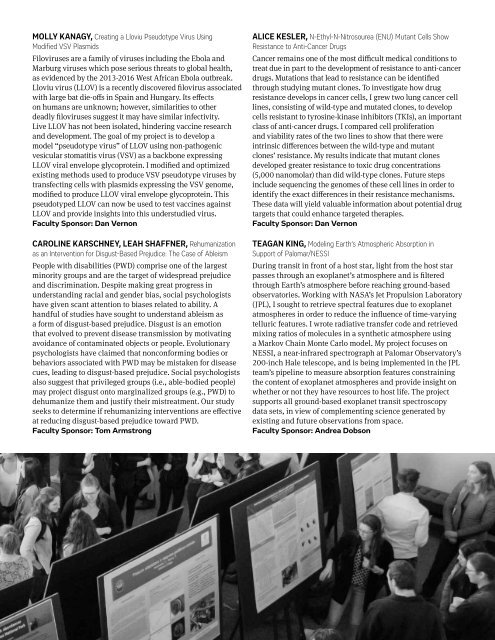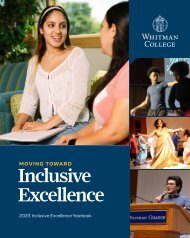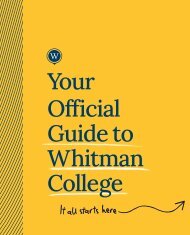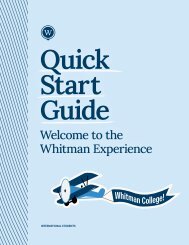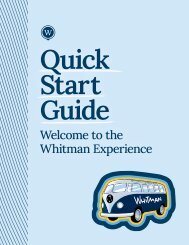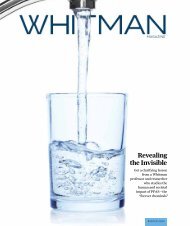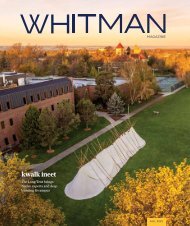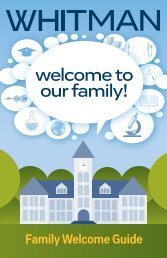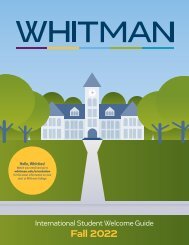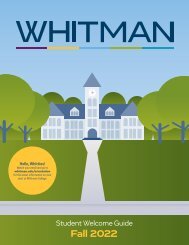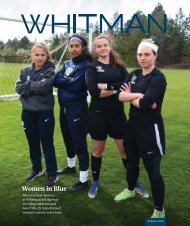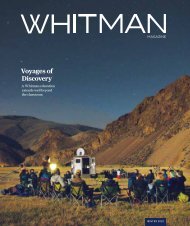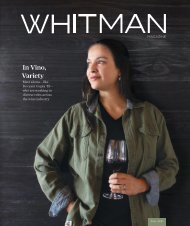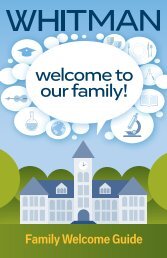You also want an ePaper? Increase the reach of your titles
YUMPU automatically turns print PDFs into web optimized ePapers that Google loves.
MOLLY KANAGY, Creating a Lloviu Pseudotype Virus Using<br />
Modified VSV Plasmids<br />
Filoviruses are a family of viruses including the Ebola and<br />
Marburg viruses which pose serious threats to global health,<br />
as evidenced by the 2013-2016 West African Ebola outbreak.<br />
Lloviu virus (LLOV) is a recently discovered filovirus associated<br />
with large bat die-offs in Spain and Hungary. Its effects<br />
on humans are unknown; however, similarities to other<br />
deadly filoviruses suggest it may have similar infectivity.<br />
Live LLOV has not been isolated, hindering vaccine research<br />
and development. The goal of my project is to develop a<br />
model “pseudotype virus” of LLOV using non-pathogenic<br />
vesicular stomatitis virus (VSV) as a backbone expressing<br />
LLOV viral envelope glycoprotein. I modified and optimized<br />
existing methods used to produce VSV pseudotype viruses by<br />
transfecting cells with plasmids expressing the VSV genome,<br />
modified to produce LLOV viral envelope glycoprotein. This<br />
pseudotyped LLOV can now be used to test vaccines against<br />
LLOV and provide insights into this understudied virus.<br />
Faculty Sponsor: Dan Vernon<br />
CAROLINE KARSCHNEY, LEAH SHAFFNER, Rehumanization<br />
as an Intervention for Disgust-Based Prejudice: The Case of Ableism<br />
People with disabilities (PWD) comprise one of the largest<br />
minority groups and are the target of widespread prejudice<br />
and discrimination. Despite making great progress in<br />
understanding racial and gender bias, social psychologists<br />
have given scant attention to biases related to ability. A<br />
handful of studies have sought to understand ableism as<br />
a form of disgust-based prejudice. Disgust is an emotion<br />
that evolved to prevent disease transmission by motivating<br />
avoidance of contaminated objects or people. Evolutionary<br />
psychologists have claimed that nonconforming bodies or<br />
behaviors associated with PWD may be mistaken for disease<br />
cues, leading to disgust-based prejudice. Social psychologists<br />
also suggest that privileged groups (i.e., able-bodied people)<br />
may project disgust onto marginalized groups (e.g., PWD) to<br />
dehumanize them and justify their mistreatment. Our study<br />
seeks to determine if rehumanizing interventions are effective<br />
at reducing disgust-based prejudice toward PWD.<br />
Faculty Sponsor: Tom Armstrong<br />
ALICE KESLER, N-Ethyl-N-Nitrosourea (ENU) Mutant Cells Show<br />
Resistance to Anti-Cancer Drugs<br />
Cancer remains one of the most difficult medical conditions to<br />
treat due in part to the development of resistance to anti-cancer<br />
drugs. Mutations that lead to resistance can be identified<br />
through studying mutant clones. To investigate how drug<br />
resistance develops in cancer cells, I grew two lung cancer cell<br />
lines, consisting of wild-type and mutated clones, to develop<br />
cells resistant to tyrosine-kinase inhibitors (TKIs), an important<br />
class of anti-cancer drugs. I compared cell proliferation<br />
and viability rates of the two lines to show that there were<br />
intrinsic differences between the wild-type and mutant<br />
clones’ resistance. My results indicate that mutant clones<br />
developed greater resistance to toxic drug concentrations<br />
(5,000 nanomolar) than did wild-type clones. Future steps<br />
include sequencing the genomes of these cell lines in order to<br />
identify the exact differences in their resistance mechanisms.<br />
These data will yield valuable information about potential drug<br />
targets that could enhance targeted therapies.<br />
Faculty Sponsor: Dan Vernon<br />
TEAGAN KING, Modeling Earth’s Atmospheric Absorption in<br />
Support of Palomar/NESSI<br />
During transit in front of a host star, light from the host star<br />
passes through an exoplanet’s atmosphere and is filtered<br />
through Earth’s atmosphere before reaching ground-based<br />
observatories. Working with NASA’s Jet Propulsion Laboratory<br />
(JPL), I sought to retrieve spectral features due to exoplanet<br />
atmospheres in order to reduce the influence of time-varying<br />
telluric features. I wrote radiative transfer code and retrieved<br />
mixing ratios of molecules in a synthetic atmosphere using<br />
a Markov Chain Monte Carlo model. My project focuses on<br />
NESSI, a near-infrared spectrograph at Palomar Observatory’s<br />
200-inch Hale telescope, and is being implemented in the JPL<br />
team’s pipeline to measure absorption features constraining<br />
the content of exoplanet atmospheres and provide insight on<br />
whether or not they have resources to host life. The project<br />
supports all ground-based exoplanet transit spectroscopy<br />
data sets, in view of complementing science generated by<br />
existing and future observations from space.<br />
Faculty Sponsor: Andrea Dobson<br />
15


